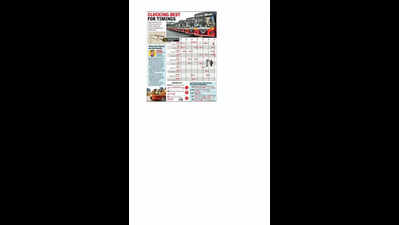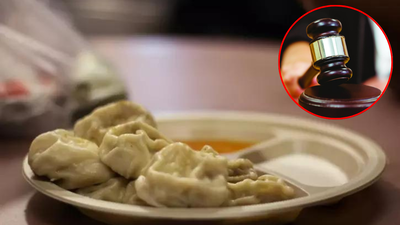Mumbai: Chandrakant Yadav, 28, a resident of Thakur Village in Kandivali and a workman in the electrical industry, faces a daily challenge in commuting, waiting at least 30 minutes for a bus on Route 434 (from Andheri to Sainath Nagar-Bamandaya pada). “Some days, the wait extends to 45 minutes. The bus app is of little help as it shows times that are never maintained.”Yadav has no choice but to wait. An auto ride would cost him up to Rs 70. But the frustration of spending a prolonged time at bus stops while watching other routes being serviced every 10-15 minutes is something that he shares with many others in the city.Hundreds of daily bus commuters are of the firm opinion that the transport utility is definitely not as ‘BEST’ as it used to be even 10 years ago, with the waiting time stretching from 30-45 minutes and sometimes over an hour.To assess the exact frequency of the service, TOI recently undertook a real-time spot check by waiting for buses on several routes across Mumbai. The findings throw light on the nature of the problems that have beset the fleet. At nearly every bus stop, short distance and feeder service routes demonstrated a strong frequency with buses arriving at intervals of 5-15 minutes. However, for the majority of longer routes, especially on north-south or east-west corridors, waiting time stretched beyond belief. At least 40% of routes in the city cover long distances, 5-10 km and above.On route 469 Limited (Maharana Pratap Chowk Mulund West to Goregaon West), a TOI correspondent noted a bus arriving around 8 am, with the next one not scheduled before 11 am—a striking three-hour gap on what was once a route with 15-20 minute frequency. “It is a sorry state of affairs. We just don’t have the buses to deploy on this route, and are using a couple of old buses just to keep it running,” said a bus station staff member managing the schedule. On another route, 302 (Mulund to Dharavi) from the same station, service was completely suspended recently due to a lack of buses.In contrast, in the same suburb, AC bus A-401 is attracting sizeable crowds. Commuters from Mulund station to Vaishali Nagar (2.5 km) form queues of 15-20 people at any given time, with observed frequencies of 3-5 minutes during peak hours and 7 minutes during off-peak times.However, take a longer route, where a bus has to negotiate its way across the length or breadth of the city, and the experience is likely to be a frustrating one. On route 434 – Agarkar Chowk Andheri station to Bamandaya pada bus stop, Andheri East, this correspondent endured a 40-minute wait. Adjacent stops for route 333 (Mahakali Caves via Chakala) and 415 (for SEEPZ) saw passengers briskly boarding buses at frequencies of 10-15 minutes. An elderly woman, Shanta Magar, waiting on route 434, said, “I come here daily and despite being old, have to wait without any proper shelter or seat (just a pole with bus number) for 40-50 minutes to catch a bus home.”Similarly, on the busy Sion-Panvel Road at Punjabwadi bus stop near TISS, TOI observed notable waiting times: route A-502 (Deonar to Nerul) 45 minutes; A-21 (Colaba to Trombay) 35 minutes; A-60 (Deonar to Borivali) 39 minutes; and A-92 (Anushakti Ngr to Tardeo) 45 minutes.At Bandra West, a spot check at the Hill Road bus stop from 4 pm onwards showed a route 215 (Bandra reclamation to Tata colony) service arriving at 4.30 pm, with locals saying the wait can sometimes go up to 40 minutes.For route A-3, Jijamata Udyan to Navy Nagar, Colaba on May 27, a check revealed waits as long as 30 minutes. This route serves Mazgaon and connects to Crawford Market, CSMT and Colaba. A commuter recalled a senior citizen who took her difficulties to the BEST management at Electric House in Colaba, but matters had hardly improved.BEST general manager SVR Srinivas admitted that waiting times are often exceeding one hour and explained that this was why routes were being restructured and reviewed for occupancy. “If it is 10-20% occupancy, we cannot deploy more buses. Proper fleet utilisation is important. We are also focusing more on shorter routes that provide last mile connectivity,” he said, adding that a commuter feedback-based study was planned.He further stated that BEST aimed to increase the load factor to 75%. “Waiting time should not exceed 10 to 15 minutes. In a city like Mumbai, or even tier 2 cities, people do not or should not wait 45 minutes to an hour. To achieve this, we have undertaken route rationalisation,” Srinivas said, adding that more buses arriving in fleet — around 1,500 by September — could improve frequency on the longer routes very soon.Analysts attributed long waits to a shortage of road-ready buses, and traffic congestion on arterial routes. Former BEST committee member Sunil Ganacharya said, “There was a time when trains would be delayed, but BEST buses would be on time, and stick to the timetable for over 500 routes. But now, you don’t know when or whether the next bus will arrive, leaving you frustrated.” (With inputs from Sunil Nair & Joeanna Rebello Fernandes)






